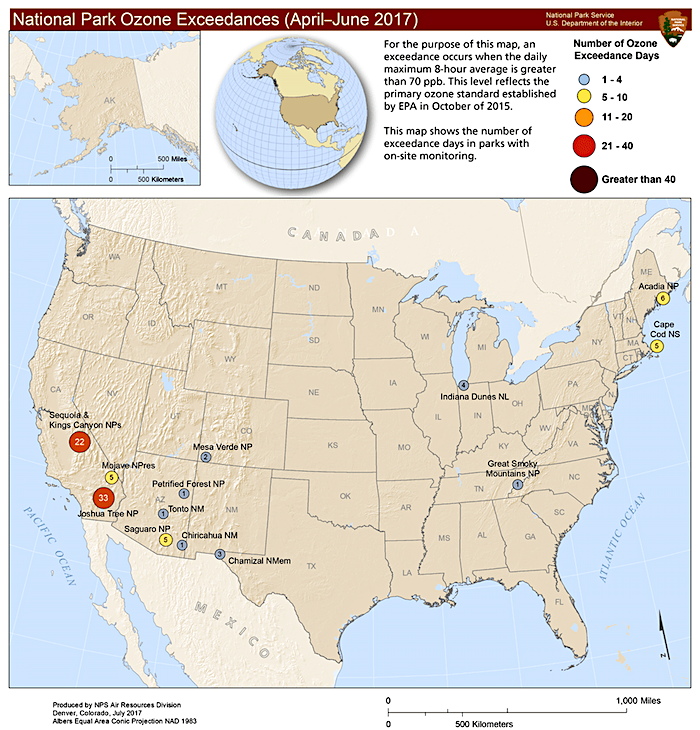
While national parks from Acadia in Maine to Sequoia in California struggle with high ground levels of ozone that are unhealthy, the Trump administration and some members of Congress want to delay regulations that would require states to reduce those levels.
Ozone forms "when pollutants emitted by cars, power plants, industrial boilers, refineries, chemical plants" react with sunlight, according to the Environmental Protection Agency. High levels can exacerabate bronchitis, emphysema, and asthma, particularly among the young and old, people who are exercising, or those who work outdoors.
The Clean Air Act of 2015 set maximum daily exposure to ozone at 70 parts per billion, down from 75 ppb, for an 8-hour average. So far this year Acadia's air quality has exceeded that 70 ppb limit on six days, with the maximum 8-hour average this year peaking at 98 ppb.
In California, meanwhile, Joshua Tree National Park, has exceeded the limit 33 times this year at Black Rock, and 18 days at Cottonwood Canyon, while Sequoia National Park has exceeded it on 22 days. Other parks that have surpassed 70 ppb this year include Chiricahua National Monument in Arizona, Mesa Verde National Park in Colorado, Petrified Forest National Park in Arizona, Saguaro National Park in Arizona, and Tonto National Monument, also in Arizona.
Against these unhealthy levels, Congress is considering legislation to keep the 75 ppb standard in place and delay the more stringent ozone standards established by the Obama administration until 2025.
U.S. Rep. Pete Olson, a Republican from Texas who introduced the House legislation that has 24 cosponsors, told Roll Call, "We want to make sure that common sense is included. With these new rules, you have to take into account jobs and the economy. Right now, they don’t do that.”
EPA Administrator Scott Pruitt last month moved until October 1, 2018, the deadline for implementing the Clean Air Act of 2015 standards.
“Republicans are leading an unprecedented assault on the standards that protect the air we breathe and save thousands of American lives every year,” Jonathan Evans, environmental health legal director at the Center for Biological Diversity, said Monday. “This appalling bill, coupled with other clean-air rollbacks by the Trump EPA, is sentencing thousands of Americans to life-threatening asthma attacks and lung and heart problems.”
Last week a number of groups, including the National Parks Conservation Association, went to court to challenge the delay in implementing the 70 ppb standard.
"EPA itself has found that ozone causes deaths, hospitalizations, asthma attacks, emergency room visits, and other serious harms, and that the existing federal limit on its concentration in the outdoor air is inadequate to protect public health," the lawsuit states. "Yet, in a preemptory action involving no public participation and only cursory explication, EPA recently extended its deadline for promulgating initial area air quality designations for the 2015 national ambient air quality standards for ozone.






Comments
And just how much do the National Parks contribute to this problem? How many millions of miles do people drive to and through the parks in not only their cars but their gas guzzling motor homes, fifth wheels and trailers? Given the widespread overcrowding of the parks it's hardly surprising the air quality suffers. It's always good to look in the mirror once in a while.